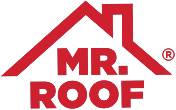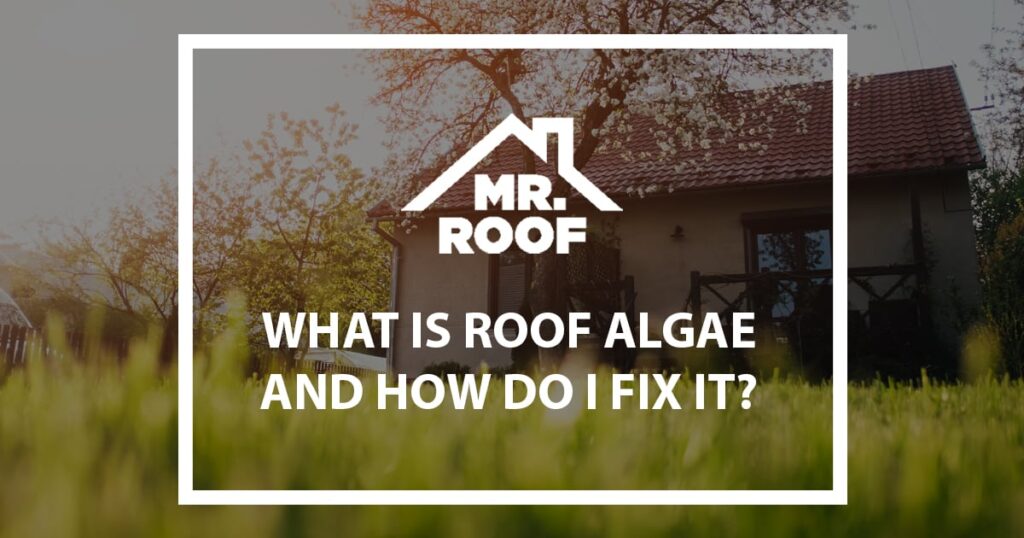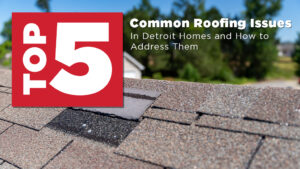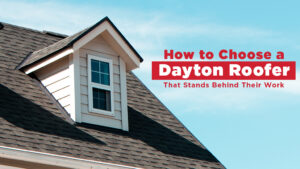Your roof can collect more than just dirt and leaves. Left to its own devices, your roofing system could also develop something more unsightly for your home: algae. A roof may develop different types of algae, lichens, and fungi as bacteria take over. Many homeowners mistake algae for “roof mold.” In most cases, however, it is really a blue-green type of algae and when it dies it leaves dark streaks on your roof.
Algae can cause unsightly stains and growths on your new roof. It will continue to worsen year after year until you invest in professional cleaning. You’ll find everything you need to know about roof algae here, in this comprehensive guide from the experts at Mr. Roof.
Our residential roofing contractors want you to learn how to recognize roof algae, understand the potential hazards it could pose to your home, and know when to call in the professionals for deep cleaning, roof repair, or roof replacement. We offer free roof inspections at locations throughout the country.
How to Recognize Roof Algae
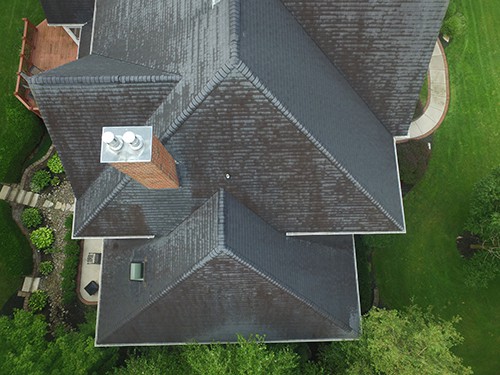 What does roof algae look like? The answer will depend on the type of problem you are experiencing. Most often, roof algae will appear as some type of discoloration to roofing materials. You may notice black stains or streaks, or a blanket of green mossy growth. Roof algae can also look like spots of mold – leading to the common misconception. Although mold can grow in your roofing materials if water gets trapped somewhere if you see any of the following on top of your roof, algae are more likely your problem:
What does roof algae look like? The answer will depend on the type of problem you are experiencing. Most often, roof algae will appear as some type of discoloration to roofing materials. You may notice black stains or streaks, or a blanket of green mossy growth. Roof algae can also look like spots of mold – leading to the common misconception. Although mold can grow in your roofing materials if water gets trapped somewhere if you see any of the following on top of your roof, algae are more likely your problem:
- Black Streaks
- Green or white spots
- Round lichens
- Mosses
- Green moss that spreads across your roof
Algae is not the same as mold. Algae is more common and not as dangerous to humans. Algae can overtake a new roof in four years or less in the right conditions. If you notice strange discoloration or vegetative growth marring the look of your new or existing roof, contact a roofing contractor near you for an inspection. A contractor can confirm the existence of algae and recommend the best course of action for your home.
What Causes Roof Algae?
Algae is a nonflowering aquatic plant that does not have roots or leaves like other plants. Roof algae can develop in certain environments. It thrives in humid atmospheres, where heat and moisture combine. Algae grow fastest in shady, damp areas, such as under large trees. It also needs nutrients to continue surviving on your home. Unfortunately, the limestone filler in most roofing shingles provides nutrients to the algae spores. The inorganic materials found in your roof will allow the algae to survive, spread, and darken.
Most cases of roof algae or fungus start with a single spore finding its way to your home. The wind can blow a spore onto your roof, and from there it will take off if the conditions are conducive enough. Rainy weather can increase the chances of algae development, but it does not need rain if there is enough humidity in the air. Overhanging branches, clogged gutters, standing water, a porous roofing material, and poor roof ventilation can all cause roof algae. Taking steps to clear your roof of common issues can help you stay ahead of algae growth.
Common Types of Roof Bacteria
Roof bacteria can take many different forms. You may think you have roof algae, when really you have moss, mildew, or mold. Roof algae generally have a black-green hue. Algae grow most often on wood and asphalt shingles or concrete tiles, especially if they do not get a lot of sunlight. The most common class of roof algae is Gloeocapsa magma, a bacterium that eats water and expels oxygen. It causes the black stains you may see on your roof. The black stains are buildups of algae that can prevent the sun from burning off the bacteria.
Roof lichen is a combination of both algae and fungus. When these two depend on each other, they can grow living organisms. Lichens will use roots to attach securely to your shingles, making them difficult to remove. If left untreated, lichen can eventually take off the top layer of your shingle – leaving a permanent scar on your roof. Roof moss is similar to lichen in that it also has root-like elements that attach to your shingles. A moss’s “roots” are rhizoids, and can anchor the moss to your roof. The moss can then create a layer of algae/lichen growth on your roof by collecting windblown soil and spores.
Unlike algae and moss, mold is not a healthy plant. Roof mold can appear as black or brown blotches, or slimy, foul-smelling accumulations. Mold can occur in places where your roof has absorbed water. Mildew is similar in that it grows on damp surfaces and can cause health problems. Mildew can take a powdery appearance and have many different shades, ranging from black to pink. All types of roof bacteria pose different threats to your roof, home, and health.
8 Ways Roof Algae Can Affect Your Roof
Roof algae is primarily a visual problem but roof mold is not. Roof mold could cause real, lasting damage to your roofing system if left untreated. For any type of damage or stain on your roof, you’ll want to get a roof inspection done by a professional.
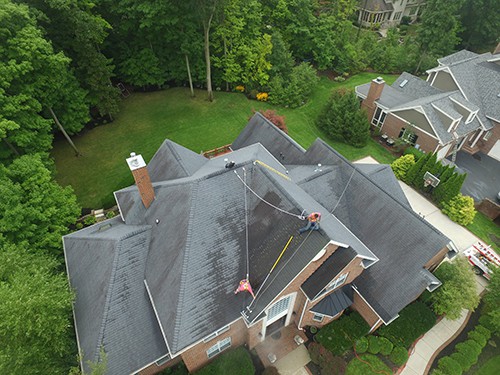 Appearance. One of the first problems homeowners experience with roof algae has to do with appearance. Most homeowners only realize they have algae when it causes ugly black streaks, dark spots, or green mossy fuzz on the roofing system. Roof algae can significantly decrease curb appeal.
Appearance. One of the first problems homeowners experience with roof algae has to do with appearance. Most homeowners only realize they have algae when it causes ugly black streaks, dark spots, or green mossy fuzz on the roofing system. Roof algae can significantly decrease curb appeal.- Home value. If you’re trying to sell your home, you may run into issues if you have roof algae. Roof algae are signs that your roofing system could have considerable damage, and may need replacing. This can decrease your home’s resale value, until and unless you schedule repairs.
- Algae and lichen can adhere to your roof, cause permanent stains, and ultimately damage the underlying materials.
- Wood rot. If moisture sinks down into the wood of your roof, you could have a serious problem on your hands. Standing water can soften and rot the wood, permanently compromising its strength and safety. Wood rot can lead to roof leaks, expensive repairs, and wood replacement.
- Mold. Another risk of moisture trapped in your roofing system is the development of real mold. Standing water and humidity, paired with growing algae spores, can be a breeding ground for harmful mold. Mold can pose serious health risks to you and your family.
- Integrity. If you allow an algae and/or mold situation to stay on your roof, it could damage its integrity beyond the point of simple repairs. Letting algae take over your roofing system for years may make the tiles irreparable, and significantly shorten a new roof’s lifespan. Rotting wood could force you to replace an unstable roof.
- Damage to other structures. Algae spores can travel on the wind and easily attach to other structures on your property. Roof algae may start on your home, but it won’t be long until you notice similar growth beginning on the roofs of sheds, barns, and carports. It could even travel to neighbors’ homes, spreading the issue throughout the neighborhood.
- Health. Lastly, but more importantly, roof algae can damage health. If algae turn into a mold or mildew problem, your family could be breathing in dangerous bacteria while spending time in your home or yard. The sooner you deal with roof algae, the better for your health and safety.
Roof algae, fungus, mildew, moss, and mold could ultimately hurt your health. Breathing in mold or mildew spores can cause respiratory problems and diseases, allergies, asthma, nausea, vision problems, and other health hazards. It is important to act quickly once you identify algae on your roof.
How to Get Rid of Roof Algae
Prevention is always the best option for dealing with roof algae. You cannot control whether the wind deposits spores onto your roof, but you can prevent the spores from developing into algae. You must make the roof an unhealthy environment for spores. Increase the amount of sun on your roof by trimming back overhanging branches. Schedule regular roof and gutter maintenance to make sure your roof wicks water away as it should. Consider paying extra for algae-resistant roofing materials if you live in a humid region. You could also treat your shingles or shakes with moisture-resistant chemicals.
If it is too late to prevent algae, treat the problem instead. Do not attempt to remove algae from your roof alone. Trying to DIY roof algae cleaning with solutions such as bleach and water could lead to expensive roof leaks or further moisture getting trapped beneath your shingles. It could also put you at health risk if you’re not careful. Furthermore, removing the fungus unprofessionally could damage your shingles – stripping them of granules and causing unsightly bald spots. Always trust roof algae repair to the professionals.
When to Call Roofing Professionals
A licensed roofing contractor will know how best to handle your roof algae issue. A professional can inspect your roofing system, determine whether the algae has caused any underlying issues, and clean your roof in a way that will not cause further damage. A contractor can then recommend ways to prevent future algae growth, such as special roof coatings or gutter replacement. If the algae have damaged your roofing system, a contractor can schedule repairs.
Contact a roofing professional the day you notice signs of potential algae growth on your roof. The longer you wait, the harder it will be to treat. Save yourself the time, money, and hassle of deeper issues by calling a roofer right away. If you see discoloration, watermarks, dark spots, peeling paint, mold on your chimney, rotting wood, or crumbling drywall, you need to call a professional roofing expert. Otherwise, you could put yourself at risk of property damage and health issues.
Do You Need Roof Cleaning, Repair, or Replacement?
When you call a contractor to deal with roof algae, you get the benefit of knowing when your shingles are irreparable. On your own, you may not notice signs of shingle problems or wood rot. A contractor, on the other hand, can detect these issues and recommend a solution. You may need either algae cleaning, shingle repair, individual shingle replacement, or a completely new roof depending on the extent of the damage.
If algae only affected a few shingles, repairs will likely suffice. If the algae penetrated deep into your roofing system, compromised the majority of your roofing tiles, or if your roof is old in general, roof replacement services might be a wiser choice. A trustworthy contractor such as Mr. Roof can give you an honest professional opinion on the state of your roofing system. We then offer lifetime warranties on new premium roofing systems, if you need replacement.
Free Roof Inspections From Mr. Roof
Mr. Roof wants to protect you from unsightly roof algae. We can visit your home and provide a free, no-obligation roof inspection. Our team of knowledgeable technicians will diagnose the algae issue, determine the extent of any property damage, and provide a free estimate for our recommended roofing services. You don’t have to worry about roof algae with Mr. Roof by your side.
